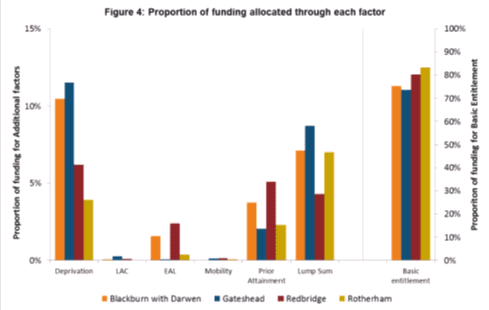Yesterday DfE released their long awaited consultation on the move towards fair school funding. Or half released – yesterday’s document was one of two, with its partner to follow at an unidentified date later this year. The second one will contain much of the juicy / interesting / substantial / controversial things in so far as it will set out the likely volume of funding and distribution, and therefore winners and losers. But this doesn’t mean this first half has nothing in. Here are ten quick observations (all on main school funding; high needs funding is outside my area of expertise)
1. This isn’t as lightweight a consultation as I and some others had feared – although the principles themselves of how to build the formula are relatively uncontroversial (an amount per pupil, more funding for pupils with additional needs, extra funds for some schools based on their characteristics and a geographic uplift), the detail of indicators is genuinely a question for discussion (for example, the mixture of pupil level and area level factors for measuring deprivation, para 2.12 to 2.22).
2. This isn’t all about London vs the rest, or even deprived urban areas vs shires. The current funding system means that similar LAs by type of population and deprivation allocate their total budgets very differently, as illustrated below; meaning similar schools in different LAs can get wildly varying sums.

3. The biggest policy decision that has been proposed is to route all funding through schools directly, rather than through LAs. This makes sense if you believe in an all Academised system, as I do, and if you want all pupils in identical situations in different areas to be funded the same way. It does mean a significantly reduced role for LAs (following the reduction in ESG funding already announced) and you can expect considerable pushback from them on this – the F40 group of low funded LAs has already flagged this as a concern. In steady state, DfE are proposing a new separate block of funding which will stay with LAs even under a hard formula, to pay for central services they will still provide for all schools like admissions, pupil welfare services (like educational psychology and attendance services) and other statutory and regulatory duties.
4. The DfE is not consulting on the weighting between pupil level factors and school level factors yet, so we don’t yet know whether they will seek to increase the minimum 80% of formula funds that currently follow the pupil, although an obvious corollary of moving all funding via schools would be to look to increase that amount further, as I’ve argued previously. That will have an impact in terms of further standardising the way in which schools operate (because if you’re not going to be funded for different physical estate set ups or other characteristics of the school other than in exceptional circumstances, then there’s no incentive to keep them and indeed an incentive to get rid of them).
5. The pupil premium stays as a separate funding stream for this Parliament. The justification for not just merging it in with the wider deprivation funding already in the formula is slightly woolly – the consultation effectively argues they’re doing different things, which they’re not. The truth is that this is a high profile area of spend and reported on and assessed separately so there’s a risk of that visibility being lost if it’s simply merged in to wider funding.
6. Although setting the ‘floor’ for the maximum amount that a school can lose every year isn’t part of this bit of the consultation, it’s interesting that the consultation repeats several times that the Minimum Funding Guarantee (MFG) which sets out the floor for schools currently, is currently set at -1.5%; it seems a reasonable signal that this is perhaps the maximum losses that losing schools will be allowed to have year on year under the transition period to a full formula.
7. There’s going to be (another) push on financial efficiency, almost certainly as a result of HM Treasury’s deal with the DfE at the time of the Spending Review to allow them to go ahead on this. I’m a little weary of these, not because they’re not a good thing, but because for some reason they never really seem to work at scale. This isn’t just a schools issue – witness the regular reports on how different NHS Trusts pay radically different amount for basic consumables like bandages and syringes for instance. The most concrete thing announced is an invest to save fund from next year, which schools will be able to access for some up front funds to allow them to make changes that bear financial savings in future years. I’m struck that DfE explicitly say (para 3.40) that it can be used (in extremis) to restructure a school’s workforce – that means redundancies in human speak. It may well be necessary, and indeed probably already is in some schools, but government has tended to be a bit coy about this in the past.
8. The funding of PFI costs will remain with local authorities for 2017-18 and 2018-19 (para 2.47), and is not going into the school based formula. The language in the section makes me think that they are unsure whether they could ever really formularise it even after a couple of years transition and understanding of the new formula. My best guess is that DfE will therefore continue to retain a very small amount of DSG centrally to distribute to LAs to handle these costs even when “all” the schools funding flows directly to schools (this small funding would also cover business rates, schools with split sites, and some other exceptional premises costs).
9. DfE have very smartly addressed the issue about consultation timings – as I’ve written about before, given the likely delay of the main consultation on funding rates, the summer recess, and extended purdah periods this year due to local and mayoral elections and also the EU referendum, there is a risk that government run out of time to consult on this in time for 2017. The way that I think they’re going to handle it is like this: this consultation is running for six weeks and is explicitly badged as part one of two. That means that if DfE do the second one in May (which, although not confirmed, is pretty much what the timetable in the consultation document suggests has to happen), and run it for a further six weeks only (albeit overlapping with EU purdah), they will fulfil the expectation that consultations should run for 12 weeks *if you take the two consultations together as a whole*. They can then lay the final details before Parliament by perhaps the end of June in advance of the summer recess, giving plenty of time to kick off the LA consultations in time for the launch of the shadow formula for 2017-18. Ta dah!
And finally,
10. London LAs will still claim that this should be solved by everyone getting as much money as them. A press release from London Councils this morning set out the position that “we will be responding to the government’s consultation on the basis that there should be a levelling up of schools funding across the country. By providing extra investment the government would be giving all schools the tools to be able to match London’s best performing schools.” File that one under “well you can’t blame them for trying”….

